Book contents
- Frontmatter
- Dedication
- Contents
- List of figures
- Acknowledgments
- Part I An approach to chivalry: was it real and practical?
- Part II Three broad chronological phases
- Part III The privileged practice of violence
- Part IV Chivalry, governing institutions, and ideals
- Part V The world of chivalric emotions
- Reflections
- Select Bibliography
- Index
Part I - An approach to chivalry: was it real and practical?
Published online by Cambridge University Press: 05 August 2016
- Frontmatter
- Dedication
- Contents
- List of figures
- Acknowledgments
- Part I An approach to chivalry: was it real and practical?
- Part II Three broad chronological phases
- Part III The privileged practice of violence
- Part IV Chivalry, governing institutions, and ideals
- Part V The world of chivalric emotions
- Reflections
- Select Bibliography
- Index
Summary
Standing securely upon its spur of rock above the Charente River in south-central France, the castle of Verteuil seemed impregnable. A French force under the duke of Bourbon was besieging the castle in 1385 as part of a campaign to sweep away garrisons of routiers who, though formally aligned to the English crown, were simply robbing and devastating the countryside for their own profit. To attack this formidable fortress, the duke relied on two classic siege techniques: he bashed parts of the defenses with stone-throwing machines (leaving several projectiles embedded in the fabric for later discovery by archaeologists), and he cut mines under the walls to topple them (and traces of these, too, have been found). The defenders had to endure the missiles, but knew how to respond more actively to the mines: they dug counter-mines, eventually intersecting the advancing tunnels of the besiegers. Armored men fought in these cramped tunnels as torches cast fantastic shadows of their hacking and thrusting figures on the chiseled rock walls. One chronicler, Jean Cabaret d'Orville (who wrote about the duke of Bourbon under the patronage of the ducal family), tells that the duke himself, wanting a share in the danger and glory, descended into the mine with a few close followers and, gripping ax and sword, battled a defender named Regnaud de Montferrand. The duke's identity remained deliberately hidden until, in the heat of combat, one of his excited followers suddenly shouted out his lord's war cry, “Bourbon! Saint Mary!” Hearing these potent and revealing words, Regnaud, a nobleman who was an unknighted squire, dropped his sword, fell to his knees, and offered to hand over the castle if only the duke would knight him, for this would be the greatest honor that could come to him. At least this is Jean Cabaret's account. Another chronicler, the famous Jean Froissart, says simply that the garrison surrendered after their leader was fatally struck by one of the massive stone projectiles flung at the fortress.
How can modern investigators understand these conflicting narratives of the capture of Verteuil and make sense of the chivalric culture they apparently reflect? Did Regnaud cheerfully surrender a strong base (from which plundering raids had sustained his band) in return for the honor of being knighted by a great lord?
- Type
- Chapter
- Information
- Medieval Chivalry , pp. 1 - 6Publisher: Cambridge University PressPrint publication year: 2016



